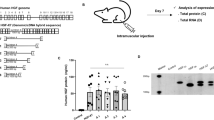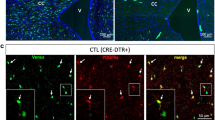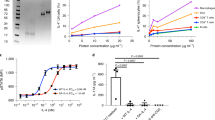Abstract
Thymulin is a thymic peptide possessing hypophysiotropic activity and antiinflammatory effects in the brain. We constructed a synthetic DNA sequence encoding met-FTS, a biologically active analog of thymulin, and subsequently cloned it into different expression vectors. A sequence optimized for expression of met-FTS in rodents, 5′-ATGCAGGCCAAGTCGCAGGGGGGGTCGAACTAGTAG-3′, was cloned in the mammalian expression vectors pCDNA3.1(+) and phMGFP (which expresses the Monster Green Fluorescent Protein), thus obtaining pcDNA3.1-metFTS and p-metFTS-hMGFP, which express met-FTS and the fluorescent fusion protein metFTS-hMGFP, respectively. The synthetic sequence was also used to construct the adenoviral vector RAd-metFTS, which expresses met-FTS. Transfection of HEK293 and BHK cells with pcDNA3.1-metFTS (experimental groups) or pcDNA3.1 (control), led to high levels of thymulin bioactivity (>600 versus <0.1 pg/ml in experimental and control supernatants, respectively). Transfection of HEK293 and BHK cells with pmetFTS-hMGFP revealed a cytoplasmic and nuclear distribution of the fluorescent fusion protein. A single intramuscular (i.m.) injection (107 plaque forming units (PFU)/mouse or 108 PFU/rat) of RAd-metFTS in thymectomized animals (nondetectable serum thymulin) restored serum thymulin levels for at least 110 and 130 days post-injection in mice and rats, respectively. We conclude that RAd-metFTS constitutes a suitable biotechnological tool for the implementation of thymulin gene therapy in animal models of chronic brain inflammation.
This is a preview of subscription content, access via your institution
Access options
Subscribe to this journal
Receive 12 print issues and online access
$259.00 per year
only $21.58 per issue
Buy this article
- Purchase on Springer Link
- Instant access to full article PDF
Prices may be subject to local taxes which are calculated during checkout







Similar content being viewed by others
References
Bach JF, Dardenne M, Pléau JM, Rosa J . Biochemical characterization of a serum thymic factor. Nature 1977; 266: 55–57.
Bach JF . Thymulin (FTS-Zn). Clin Immunol Allergy 1983; 3: 133–156.
Gastinel LN, Dardenne M, Pléau JM, Bach JF . Studies on the zinc-binding site to the serum thymic factor. Biochim Biophys Acta 1984; 797: 147–155.
Dardenne M, Pléau JM, Nabarra B, Lefrancier P, Derrien M, Choay J et al. Contribution of zinc and other metals to the biological activity of serum thymic factor (FTS). Proc Natl Acad Sci USA 1982; 79: 5370–5373.
Cung MT, Marraud M, Lefrancier P, Dardenne M, Bach JF, Laussac JP . NMR study of a lymphocyte differentiating thymic factor. J Biol Chem 1988; 263: 5574–5580.
Goya RG, Brown OA, Pléau JM, Dardenne M . Thymulin and the neuroendocrine system. Peptides 2004; 25: 139–142.
Safieh-Garabedian B, Dardenne M, Pleau JM, Saadé NE . Potent analgesic and anti-inflammatory actions of a novel thymulin-related peptide in the rat. Br J Pharmacol 2002; 136: 947–955.
Safieh-Garabedian B, Ochoa-Chaar CI, Poole S, Massaad CA, Atweh SF, Jabbur SJ et al. Thymulin reverses inflammatory hyperalgesia and modulates the increased concentration of proinflammatory cytokines induced by i.c.v. endotoxin injection. Neuroscience 2003; 121: 865–873.
Goya RG, Cónsole GM, Hereñú CB, Brown OA, Rimoldi OJ . Thymus and aging: potential of gene therapy for restoration of endocrine thymic function in thymus-deficient animal models. Gerontology 2002; 48: 325–328.
http://www.ncbi.nlm.nih.gov/Taxonomy/Utils/wprintgc.cgi?mode=c.
Calenda A, Cordonnier A, Lederer F, Le DKH, Pléau JM . Production of biologically active thymulin in Escherichia coli through expression of a chemically synthesized gene. Biotechnol Lett 1988; 10: 155–160.
Wan YP, Folkers K . Synthesis of the facteur thymique sérique and an analogue also related to thymopoietin. Bioorganic Chem 1979; 8: 35–39.
Imaizumi A, Gyotoku J, Terada S, Kimoto E . Structural requirement for the biological activity of serum thymic factor. FEBS Lett 1981; 128: 108–110.
Bach JF, Dardenne M . Thymic hormones in immunological diseases. Immunol Allergy Pract 1984; 6: 15–20.
Schmitt D, Monier JC, Dardenne M, Pleau JM, Deschaux P, Bach JF . Cytoplasmic localization of FTS (Facteur Thymique Serique) in thymic epithelial cells. An immunoelectron-microscopical study. Thymus 1980; 2: 177–186.
Auger C, Monier JC, Savino W, Dardenne M . Localization of thymulin (FTS-Zn) in mouse thymus. Comparative data using monoclonal antibodies following different plastic embedding procedures. Biol Cell 1984; 52: 139–146.
Savino W, Dardenne M . Thymic hormone-containing cells. VIII. Effects of colchicine, cytochalasin B, and monensin on secretion of thymulin by cultured human thymic epithelial cells. J Histochem Cytochem 1986; 34: 1719–1723.
Rivera VM, Ye X, Courage NL, Sachar J, Cerasoli Jr F, Wilson JM et al. Long-term regulated expression of growth hormone in mice after intramuscular gene transfer. Proc Natl Acad Sci USA 1999; 96: 8657–8662.
Marshall DJ, Leiden JM . Recent advances in skeletal-muscle-based gene therapy. Curr Opin Genet Dev 1998; 8: 360–365.
Bach JF, Dardenne M, Goldstein AL . Clinical Aspects of thymulin (FTS). In: Goldstein AL (ed). Thymic Hormones and Lymphokines. Basic Chemistry and Clinical Applications. Plenum Press: New York, 1984, pp. 593–600.
The Biological Council Animal Research & Welfare Panel. Guidelines on Handling and Training of Laboratory Animals. UFAW: Perth, 1992.
Kasahara S, Itoh T . Separation and characterization of rat thymocyte subpopulations. Thymus 1985; 7: 301–316.
Sambrook J, Russell DW . Molecular Cloning: A Laboratory Manual. Cold Spring Harbor Laboratory Press: Cold Spring Harbor, 2001.
Hitt M, Bett A, Prevec L, Graham FL . Construction and propagation of human adenovirus vectors. In: Celis J (ed). Cell Biology: A Laboratory Handbook. Academic Press: New York, 1998, pp. 1500–1512.
Dardenne M, Bach JF . The sheep cell rosette assay for the evaluation of thymic hormones. In: Van Bekkum DW, Kruisbeek AM (eds). Biological Activity of Thymic Hormones. International Workshop and Symposium. Kooyker Scientific Publications. Halsted Press Division, Wiley: Rotterdam, Netherlands, 1975, pp. 235–243.
Metreau E, Pléau JM, Dardenne M, Bach JF, Pradelles P . An enzyme immunoassay for synthetic thymulin. J Immunol Meth 1987; 102: 233–242.
Acknowledgements
The authors are grateful to Ms Yolanda Sosa for technical assistance and Dr Maria José Bellini for assistance with digital microphotograpy. This work was supported in part by NIH Grant #R21TW6665, grants from the Argentine Research Council (CONICET) and Grant #PICT10663 from the National Agency for the Promotion of Science and Technology (ANPCyT) to RGG, and by the Institut National de la Santé et de la Recherche Médicale (INSERM), France, to MD and RGG. PCR and CBH are ANPCyT and CONICET doctoral fellows, respectively. OAB, OJR and RGG are career researchers of CONICET.
Author information
Authors and Affiliations
Corresponding author
Rights and permissions
About this article
Cite this article
Reggiani, P., Hereñú, C., Rimoldi, O. et al. Gene therapy for long-term restoration of circulating thymulin in thymectomized mice and rats. Gene Ther 13, 1214–1221 (2006). https://doi.org/10.1038/sj.gt.3302775
Received:
Revised:
Accepted:
Published:
Issue Date:
DOI: https://doi.org/10.1038/sj.gt.3302775



